John Seymour Lucas RA
British, (1849-1923)Stolen Despatches
Oil on canvas, signed & dated 1882
Provenance: N Mitchell, Duke Street, London
A wonderfully detailed historical painting of a prisoner being brought before a general by John Seymour Lucas. Two soldiers can be seen forcing an older man dressed in civilian clothes to stand before two Georgian officers at a table. The uniform of the soldiers is similar to those worn by British soldiers during the American War of Independence (1775-1783). The painting could well be referencing the civilian spies organised by George Washington.
John Seymour Lucas was born in London on 21 December, 1849 to Henry and Elizabeth Lucas (née Seymour). He was the nephew of the portrait painter John Lucas and two of his children, Sydney Seymour Lucas and Marie Ellen Seymour Lucas also became artists. His father was a coach joiner and Lucas initially trained as a woodcarver, however, encouraged by his uncle he became an apprentice to a sculptor. At the age of 16, he decided to pursue a career in painting and began studying with his cousin John Templeton Lucas (1836-1880) in his spare time before attending the St. Martin's Lane Art School. By 1871, he had entered the Royal Academy School and during the same year began exhibiting at the Royal Society of British Artists (RSBA). In 1872, he made his debut at the Royal Academy exhibitions. He was later elected an associate member of the RA in 1876 and a full Academician in 1898.
In 1877, he married the Parisian artist Marie Cornelissen (1850-1921) who was the daughter of the artist and colourman Louis Cornelissen. She attended the St Martin’s Lane and Royal Academy schools where they met and also went on to exhibit at the RA and RSBA. Later in the same year, Lucas was elected a member of the New Society of Painters in Watercolours. He continued his artistic education, travelling around Europe where he studied the Flemish and Spanish Masters and was particularly inspired by van Dyck and Velázquez. On his return, he began painting historical scenes from the 16th to 18th century including the Spanish Armada, English Civil War and the Jacobite rebellions. His works were highly detailed and contained accurate portrayals of period costumes and interiors.
During the late 1880’s his reputation flourished and he became friends with John Singer Sargent. A portrait of him by Singer Sargent is held at the National Portrait Gallery. His success led to commissions for a number of major works for prestigious public buildings and royal clients including Queen Victoria. As well as producing paintings, he also designed sets and costumes for theatres.
From 1882, he lived at Woodchurch Road in Hampstead where he built a studio. Towards the end of World War I, Lucas moved to Blythburgh, Suffolk where he remained until his death on 8 May, 1923. His works can be found in a number of public collections including Bristol Museum, Hartlepool Museum, Laing Art Gallery, Orleans House Gallery, Royal Academy of Arts, Royal Armouries Museum, the Tate, Victoria & Albert Museum, Walker Art Gallery, Wolverhampton Art Gallery and more.
© Benton Fine Art
| Presentation | The painting is housed in a new, English made gilt frame which is in excellent condition. The reverse retains old label for N Mitchell, an art dealership established around 1875 by Nathan Mitchell at 52 Copthall Avenue, London. By 1909, it had opened a branch at 49 Duke Street, remaining there until 1929 when it relocated to 2 Duke Street. The business later took over the premises next door, operating at 2 & 3 Duke Street until Nathan’s death in 1945. The dealership was continued by his son George who ran it as Mitchell Galleries Ltd until his death in 1951. The painting also bears a label for Pettus House, an antique dealership based in Norwich. |
| Condition | As with all of our original antique oil paintings, this work is offered in ready to hang gallery condition, having been professionally cleaned, restored and revarnished. |
Dimensions
| Image Size | 19.5 inches x 29.5 inches (49.5cm x 75cm) |
| Framed Size | 27 inches x 37 inches (68.5cm x 94cm) |
You May Also Like











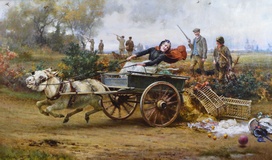
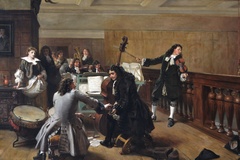
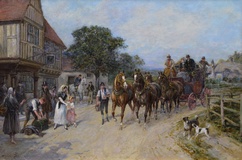
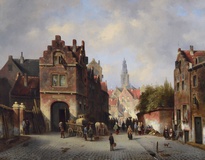
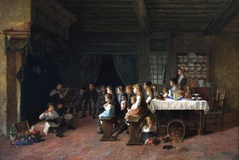
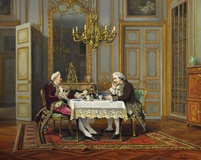
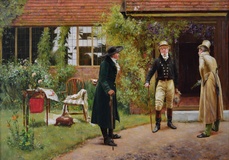
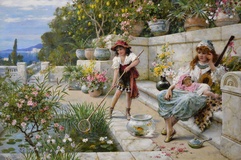
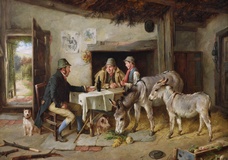
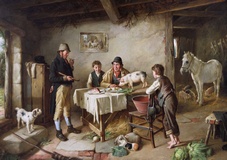
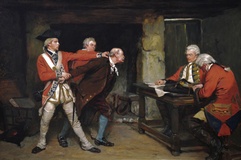 Stolen Despatches - John Seymour Lucas RA
Stolen Despatches - John Seymour Lucas RA

